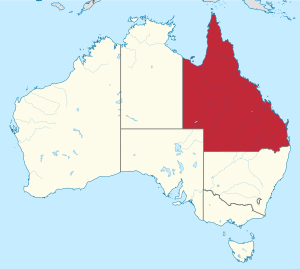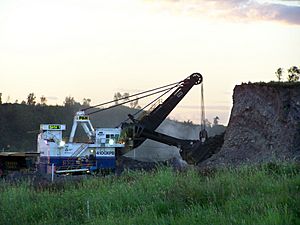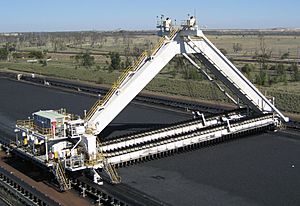Bowen Basin Coalfields facts for kids
The Bowen Basin Coalfields holds the biggest coal supplies in Australia. This important area has one of the world's largest amounts of a special type of coal called bituminous coal. It also has almost all of Queensland's best coking coal, which is used to make steel. The basin was named after the Bowen River, which got its name from Queensland's first Governor, Sir George Bowen.
The Bowen Basin covers a huge area of over 60,000 square kilometres in Central Queensland. It stretches from Collinsville in the north down to Theodore in the south. A small reptile called the ornamental snake also lives in this region.
Contents
History of Coal in the Bowen Basin
The Bowen Basin is about 600 kilometres long and 250 kilometres wide. It holds about 70% of all the coal in Queensland. This coal formed a very long time ago, during the Permian age. It's super important for business, providing almost all of Queensland's coking coal and 60% of its thermal coal (which is used for power). In 2006-2007, the top ten coal mines in Queensland were all located here.
Early Mining Efforts
People started mining coal in the Bowen Basin for money in the 1890s at Blair Athol. Back then, most coal came from other areas like West Moreton. These early mines mainly sold thermal coal to local customers, especially the railway system. For a mine to do well, its coal had to be good for train engines, and it needed to be close to a railway line. Many early mines in the Bowen Basin found it hard to make enough money.
The Coal Rush
A big search for coal in the Bowen Basin started after 1907. This was when prices for other metals dropped, making people look for new valuable resources. Tests done in 1912 and 1913 caused a "coal rush" to the area. Many groups tried to get land to mine. However, in 1915, the Queensland government decided to keep a large area for state-run mining instead of letting private companies have it.
Building the railway line to transport the coal took five years, finishing in 1922. This long wait caused many people who wanted to mine to give up. Eventually, the remaining groups joined together to form the Bowen Consolidated Coal Mining Company. This company then set up the Bowen Consolidated Colliery in Scottville.
Mining Today
Most of the coal mines in the Bowen Basin are in the northern part. These include both open cut mines (where coal is dug from the surface) and underground mines. In August 2011, there were 48 active coal mines in the basin. At that time, the government said that over 50 new mining projects were being planned for the Bowen Basin.
The Goonyella railway line is the main way coal is transported for export. It takes coal to ports like Dalrymple Bay and Hay Point. Coal is also sent out through the Port of Gladstone. The Kestrel coal mine, near Emerald, was even named after a type of bird found in the area!
Important Coal Mines
Some of the large coal mines in the Bowen Basin include:
- Byerwen Mine
- Curragh coal mine
- Dawson Central Mine
- Goonyella Riverside Mine
- Hail Creek coal mine
- Peak Downs Mine
- Saraji coal mine
Other mines in the basin are Foxleigh coal mine, Coppabella coal mine, Collinsville coal mine, Blair Athol coal mine, Middlemount coal mine, Yarrabee coal mine, South Walker Creek coal mine, Rolleston coal mine, Oaky Creek coal mine, Norwich Park coal mine, North Goonyella coal mine, Newlands coal mine, Moranbah North coal mine, Kestrel coal mine, Jellinbah coal mine, Gregory coal mine, Blackwater coal mine, Broadmeadow, Daunia, Caval Ridge, Poitrel and German Creek coal mine.
Mining Companies
Many different companies operate mines in the Bowen Basin. Some of them are:
- BHP Mitsubishi Alliance
- Felix Resources
- Idemitsu Kosan
- Macarthur Coal
- Peabody Energy
- QCoal
- Vale
- Wesfarmers
- Glencore
- Rio Tinto
Discovering Coal
The first European to find coal in this region was Ludwig Leichhardt in 1845. Later, in 1878, a government geologist named Robert Logan Jack also reported finding coal. The first attempt to mine coal was in 1892 at Tolmies, but this mine was closed by 1900. Large-scale exploration for coal in the Bowen Basin really took off in the 1960s.
In 2006, 60% of Australia's exported coking coal came from the Bowen Basin. In 2010, many mines in the basin were affected by huge floods. This meant they couldn't send out as much coal as they had promised.
Gas Fields
Besides coal, the Bowen Basin also has natural gas. This gas is often found in the coal seams themselves.
Fairview Gas Field
The Fairview gas field is a project that extracts coal seam gas from the Bowen Basin. It's located about 500-600 kilometres north-west of Brisbane. The company Santos Limited operates this project.
The first gas well, Fairview 1, was drilled in 1994. Gas production started in 1995, and the first gas was sold in 1998. By the end of 2005, over 100 wells had been drilled in the Fairview area. The gas is collected, cleaned, and then sent through pipelines to be sold. Plans are in place to increase how much gas can be produced from this field in the future.
Scotia Gas Field
The Scotia gas field is another gas field in the Bowen Basin. It's located about 340 kilometres north-west of Brisbane. Santos Limited also operates this field.
The first well, Scotia 3, was drilled in 1996. Gas production from coal seams started in 2002. This field supplies gas to CS Energy's gas-fired power station for 15 years under a contract. The Scotia field has 25 wells that send gas to a central processing plant. The cleaned gas is then sent through a pipeline to join a larger gas pipeline system.
Environmental Concerns
Mining and exporting coal and gas can have an impact on the environment. There have been protests about expanding the Gladstone port at Curtis Island. This is because the port is close to the World Heritage Listed Great Barrier Reef. UNESCO, a global organization, has asked for more environmental checks on the port plans. People are also worried about pollution affecting the water in the Great Artesian Basin, a huge underground water supply.




